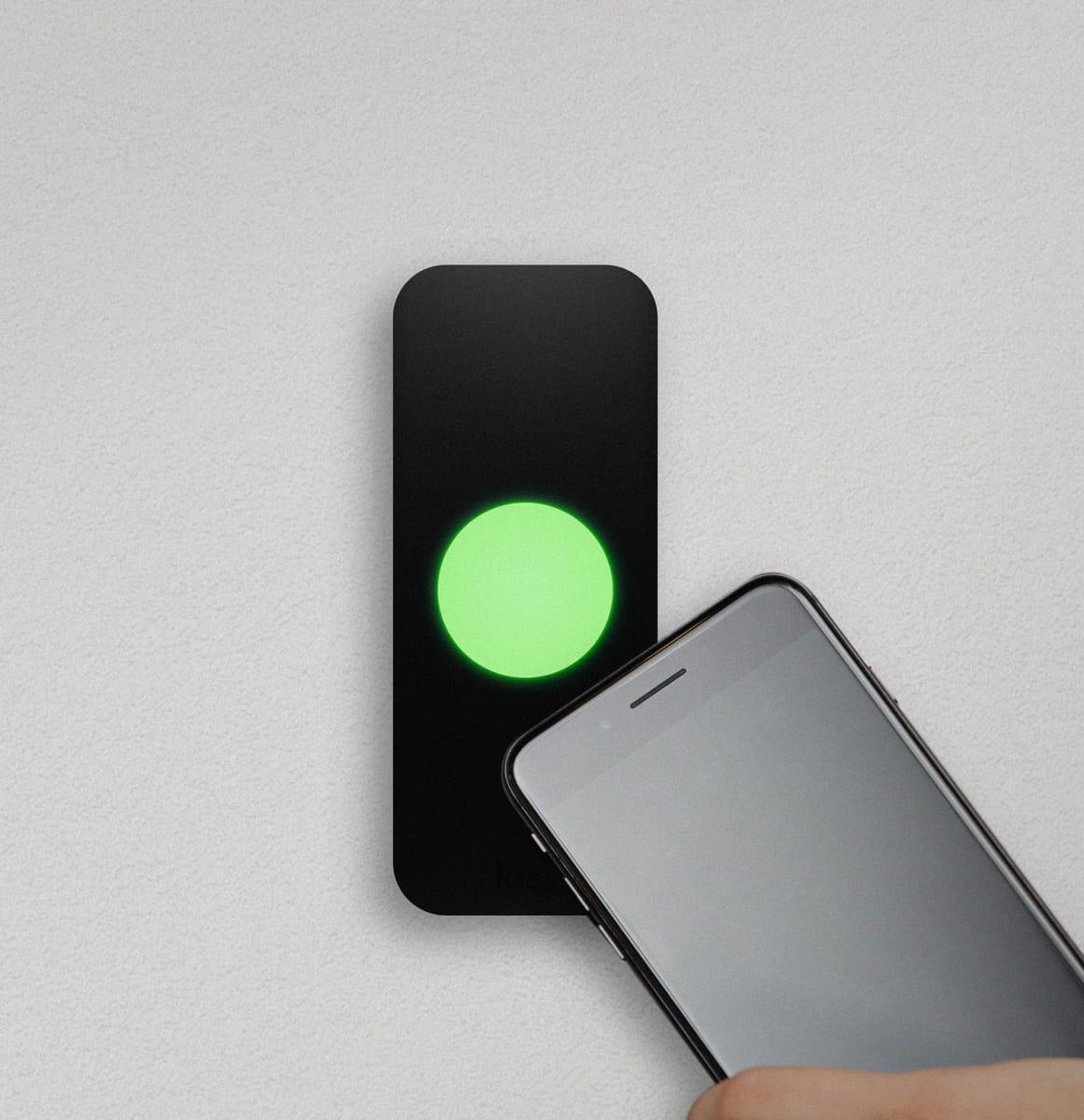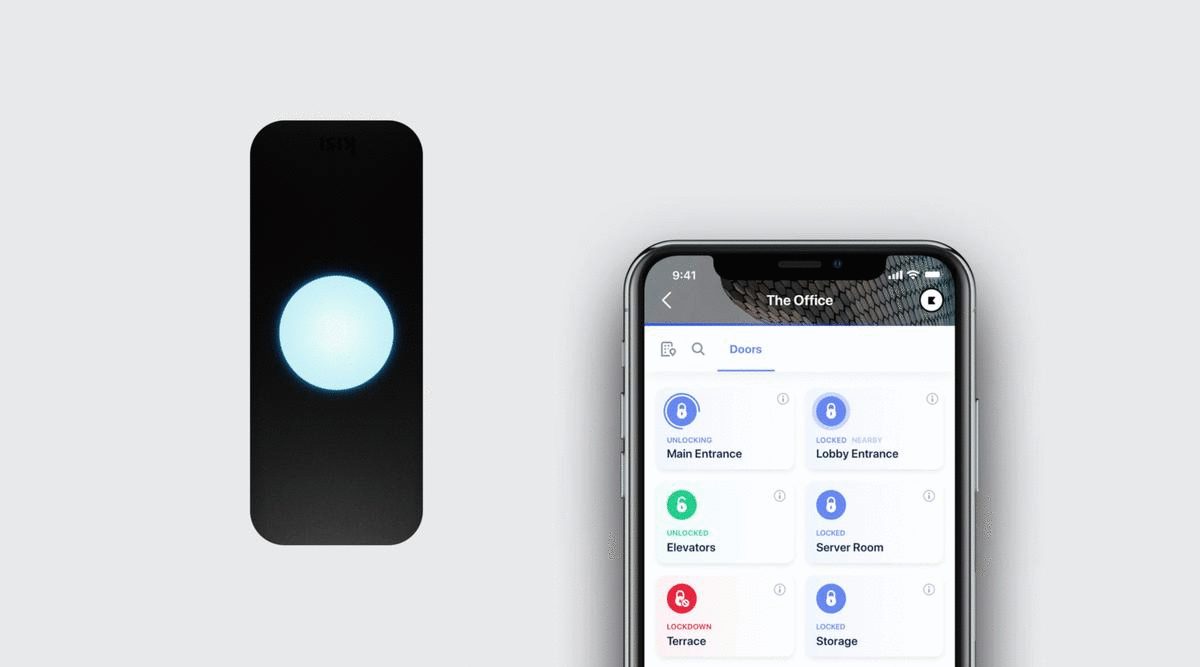Kisi removes the hassle of managing access through cloud-based automation, allowing you to quickly deploy custom access rights for staff and members, as well as temporary guest access rights for visitors. Our cloud-based technology enables remote global management, hybrid work, and real-time monitoring at scale. Learn more about Kisi’s access control products and the benefits of access control.
What is cloud-based access control? #
A cloud-based access control system provides centralized management, visibility, and control without the cost and complexity of traditional physical access systems. Besides reliable access hardware, systems like Kisi provide intuitive software equipped with centralized management, real-time updates, diagnostics, and more. They can be deployed rapidly without training or proprietary command-line interfaces. Plus, they provide integrations with the software your company uses for its operations, visitor management, and door scheduling.

Features of cloud-based access control #
Cloud-based access control has a number of features that make it very convenient. Thanks to the newest cloud technology, the following processes can be managed remotely:
- Verification of the system operation
- Adding new users to access control groups
- Revoking rights to access certain facilities
- Lockdown feature for emergencies
- Offline unlock capabilities
- Changing users’ rights instantly and remotely
- Access point reprogramming
- Heatmap of entry events
- Exportable access logs for admins
- Integrations with the software you already use, like Asana, Azure, G Suite, Doorbird, and many more, plus our Kisi API
Wireless capabilities provide an increased level of flexibility and scalability, and the security of multiple offices can be put under one umbrella; information received from each and every office is saved in one single place in the cloud.
When making use of cloud access control, you can monitor live-stream videos from any device at any time. Thus, your security needs can be addressed in real-time and you don't have to hire an in-house security specialist. Instead, your access control provider will help you to monitor any security-related issues.
Cloud-based security vs. traditional #
When we think of legacy access control, it has the following drawbacks compared to a cloud-based physical access control system:
- Higher upfront costs (e.g., the purchase of local servers and other hardware)
- Proprietary legacy systems make it harder to change to a different security vendor
- Centralized controllers are usually limited to a certain number of doors
- They require the presence of an on-site specialist who can react to an issue if it arises
By having a cloud-based physical access control system, you turn your capital expenses into operational ones. There are no high costs associated with the purchase of servers and wiring to connect all the components of access control, allowing for increased scalability and flexibility. Additionally, the number of doors and users you can add to the system is unlimited. Last but not least, IP access control can be seamlessly integrated with building management systems, video surveillance, and fire alarms—unlike traditional access control, where a physical interface is required for communication.
Return on investment with a cloud-based system #
For a full summary of return on investment, you can read this sheet. Otherwise, here are the main points:
With the cloud: #
- You don’t need a local server, all your data is hosted on a secure remote server, eliminating maintenance and training costs
- Free, over-the-air security and feature updates
- Free tech assistance from a dedicated in-house support team
Without the cloud: #
- Expensive hidden costs, like hourly maintenance or extra fees for software updates and training
- It’s more complicated—and costly—to manage your system remotely
- Older systems are often too complex to easily delegate to other team members

Finding a reliable provider #
First, you’ll want to try to find out as much as possible about a service provider’s reputation. Start by reading online reviews of the best access control systems and familiarizing yourself with the scope of services you'll be offered.
Some important points to consider when comparing access-control systems include:
- How easy is it to migrate to the solution?
- Does the provider offer tailored migration paths?
- Do they provide 24/7/365 support?
- Is the system compatible with your locks?
- Are there biometric or mobile access credentials available?
- Is the software easy to use and onboard?
- Can the system be integrated with fire alarms and CCTV?
- What does the monthly fee depend on (quantity of users/entry points, etc.)?
- What is the provider’s level of data and system security?
- Is this vendor compliant with Risk Management Framework?
A cloud-based physical access control system is advantageous to many organizations because it turns complex security processes into simpler, more flexible, and scalable solutions. From the lack of local servers and proprietary equipment to remote control and customizable reports, it makes security devices easier to install and manage.

Why move your access control to the cloud? #
In the past, companies ran their access control system on a physical computer in their buildings, but cloud systems now allow companies to manage and control their doors through the internet. When you update your payroll through companies like Namely, Justworks, or Gusto, you’re using cloud computing. Checking your company bank balance on your phone? You are in the cloud again. Chances are, you rely more and more on cloud computing to solve challenges faced by your growing company without even knowing it.
Access control is just one more way cloud computing can help your company grow and ease management woes. Still need convincing to move your door access control system to the cloud? Not only does it increase the efficiency and security of your company, it ultimately makes you more competitive. Check out these nine other reasons:
1. Flexibility #
Cloud-based access control is ideal for growing businesses with fluctuating workforces (e.g., freelancers, interns, and contractors). Centrally managing and monitoring access rights across a growing number of office locations provides a real advantage over competitors.
2. Compliance #
Do you need to submit the access log of your offices on a monthly basis? With cloud-based access control, you simply log into the web portal and download the relevant data. No more transferring data from on-premise systems.
3. Automatic software updates #
The beauty of cloud access control systems is that the servers are off-premise—out of sight and out of your way. Suppliers manage the servers and release regular software updates, including new features and security updates, so you don’t have to waste time maintaining the different systems across your locations. This way, you can focus on the things that really matter to grow your business.
4. Capital-expenditure free #
Cloud access control systems cut out the high cost of hardware and let you simply pay as you go. The subscription-based model optimizes your cash flow. Plus, the ease of setup and the management of the system saves on considerable internal resources.
5. Increased collaboration #
Your team can view and edit access rights anytime and anywhere with cloud-based access control, allowing for more efficient workflows without losing control. The different admin roles and levels of visibility can empower your teammates without you losing any control.
6. Work from anywhere #
With cloud access control you can manage and monitor access to your offices from anywhere you have an internet connection. This way, your office is never at risk of being accessed by retired employees or contractors.
7. Synchronized data #
The more employees collaborate with external partners and freelancers, the greater the need to have a watertight access control system in place. Before, cloud systems workers had to receive and eventually hand back access cards. With this sort of system, sooner or later, you end up with chaos: People still have access to your offices but are no longer affiliated with your company. This is a huge risk for your business and your employees.
When introducing a cloud access management system, all access rights are stored centrally and can be seen with a few mouse clicks. You can easily update the system with the latest list of people who should have access to the offices, set expiration dates of keys for compliance, or even integrate with your SSO or SCIM provider for automated provisioning.
8. Security #
Greater than the loss of expensive equipment is the loss of sensitive data that puts your company at risk. Updating the access control system from anywhere gives you the ability to update or delete access rights immediately. Furthermore, you can synchronize floor access rights with your HR database.
9. Competitiveness #
Cloud access control systems are real-time and allow you to act faster than on-premise systems. Moving to the cloud with your access control gives you access to enterprise-class technology for all of your locations.

